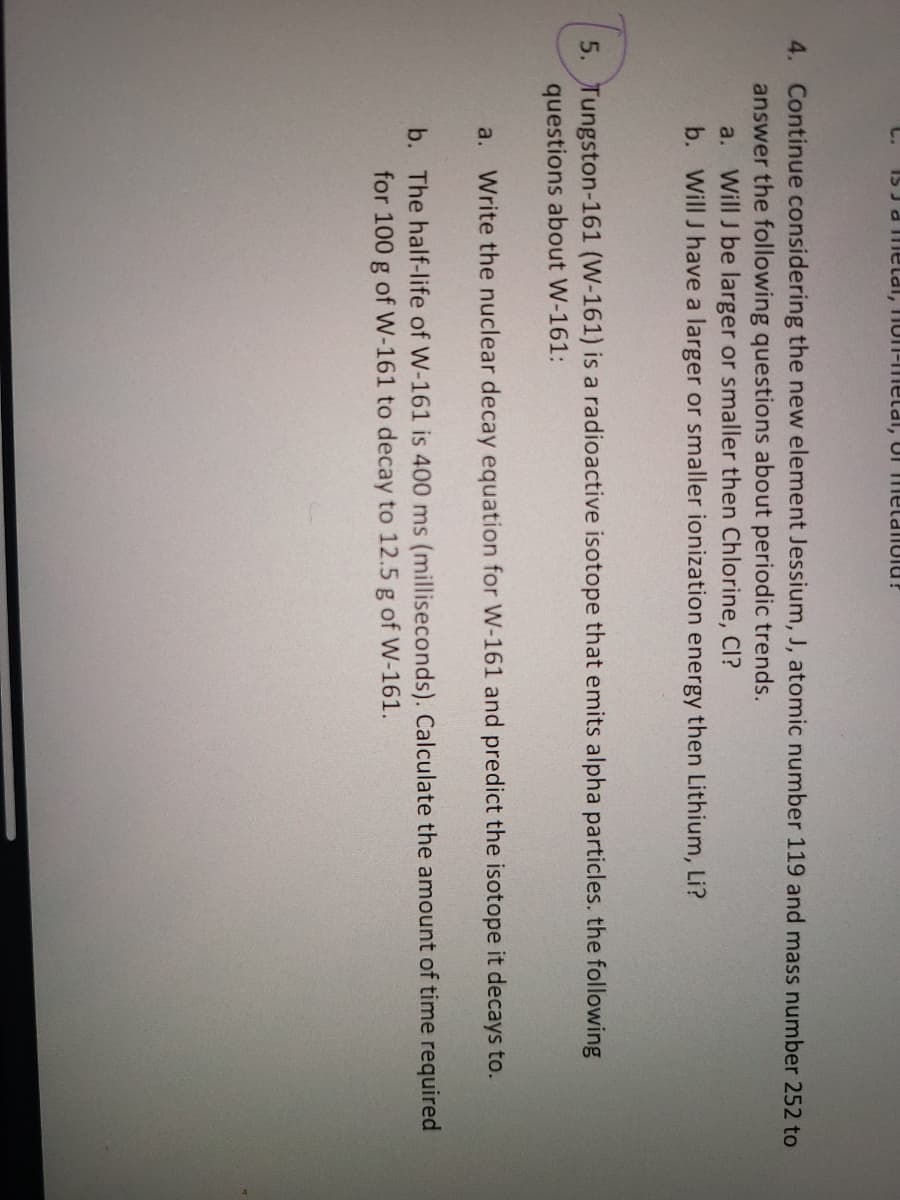e considering the new element Jessium, J, atomic number 119 a che following questions about periodic trends. Vill J be larger or smaller then Chlorine, CI? Vill J have a larger or smaller ionization energy then Lithium, Li? n-161 (W-161) is a radioactive isotope that emits alpha particle: as about W-161: Vrite the nuclear decay equation for W-161 and predict the isot The half-life of W-161 is 400 ms (milliseconds). Calculate the am or 100 g of W-161 to decay to 12.5 g of W-161.
e considering the new element Jessium, J, atomic number 119 a che following questions about periodic trends. Vill J be larger or smaller then Chlorine, CI? Vill J have a larger or smaller ionization energy then Lithium, Li? n-161 (W-161) is a radioactive isotope that emits alpha particle: as about W-161: Vrite the nuclear decay equation for W-161 and predict the isot The half-life of W-161 is 400 ms (milliseconds). Calculate the am or 100 g of W-161 to decay to 12.5 g of W-161.
World of Chemistry, 3rd edition
3rd Edition
ISBN:9781133109655
Author:Steven S. Zumdahl, Susan L. Zumdahl, Donald J. DeCoste
Publisher:Steven S. Zumdahl, Susan L. Zumdahl, Donald J. DeCoste
Chapter11: Modern Atomic Theory
Section: Chapter Questions
Problem 75A
Related questions
Question
100%
Please answer number 5 letter A only

Transcribed Image Text:C.
IS Ja melal, nuT-melai, Uf melanulu?
4. Continue considering the new element Jessium, J, atomic number 119 and mass number 252 to
answer the following questions about periodic trends.
a. Will J be larger or smaller then Chlorine, Cl?
b. Will J have a larger or smaller ionization energy then Lithium, Li?
5. Tungston-161 (W-161) is a radioactive isotope that emits alpha particles. the following
questions about W-161:
a. Write the nuclear decay equation for W-161 and predict the isotope it decays to.
b. The half-life of W-161 is 400 ms (milliseconds). Calculate the amount of time required
for 100 g of W-161 to decay to 12.5 g of W-161.
Expert Solution
Step 1
Radioactive isotope are not stable. To get stabalize radioactive isotope emit radiation in the form of alpha, beta and gamma particles.
Trending now
This is a popular solution!
Step by step
Solved in 2 steps with 1 images

Knowledge Booster
Learn more about
Need a deep-dive on the concept behind this application? Look no further. Learn more about this topic, chemistry and related others by exploring similar questions and additional content below.Recommended textbooks for you

World of Chemistry, 3rd edition
Chemistry
ISBN:
9781133109655
Author:
Steven S. Zumdahl, Susan L. Zumdahl, Donald J. DeCoste
Publisher:
Brooks / Cole / Cengage Learning

General Chemistry - Standalone book (MindTap Cour…
Chemistry
ISBN:
9781305580343
Author:
Steven D. Gammon, Ebbing, Darrell Ebbing, Steven D., Darrell; Gammon, Darrell Ebbing; Steven D. Gammon, Darrell D.; Gammon, Ebbing; Steven D. Gammon; Darrell
Publisher:
Cengage Learning

Chemistry: An Atoms First Approach
Chemistry
ISBN:
9781305079243
Author:
Steven S. Zumdahl, Susan A. Zumdahl
Publisher:
Cengage Learning

World of Chemistry, 3rd edition
Chemistry
ISBN:
9781133109655
Author:
Steven S. Zumdahl, Susan L. Zumdahl, Donald J. DeCoste
Publisher:
Brooks / Cole / Cengage Learning

General Chemistry - Standalone book (MindTap Cour…
Chemistry
ISBN:
9781305580343
Author:
Steven D. Gammon, Ebbing, Darrell Ebbing, Steven D., Darrell; Gammon, Darrell Ebbing; Steven D. Gammon, Darrell D.; Gammon, Ebbing; Steven D. Gammon; Darrell
Publisher:
Cengage Learning

Chemistry: An Atoms First Approach
Chemistry
ISBN:
9781305079243
Author:
Steven S. Zumdahl, Susan A. Zumdahl
Publisher:
Cengage Learning

Chemistry
Chemistry
ISBN:
9781305957404
Author:
Steven S. Zumdahl, Susan A. Zumdahl, Donald J. DeCoste
Publisher:
Cengage Learning


Chemistry & Chemical Reactivity
Chemistry
ISBN:
9781133949640
Author:
John C. Kotz, Paul M. Treichel, John Townsend, David Treichel
Publisher:
Cengage Learning